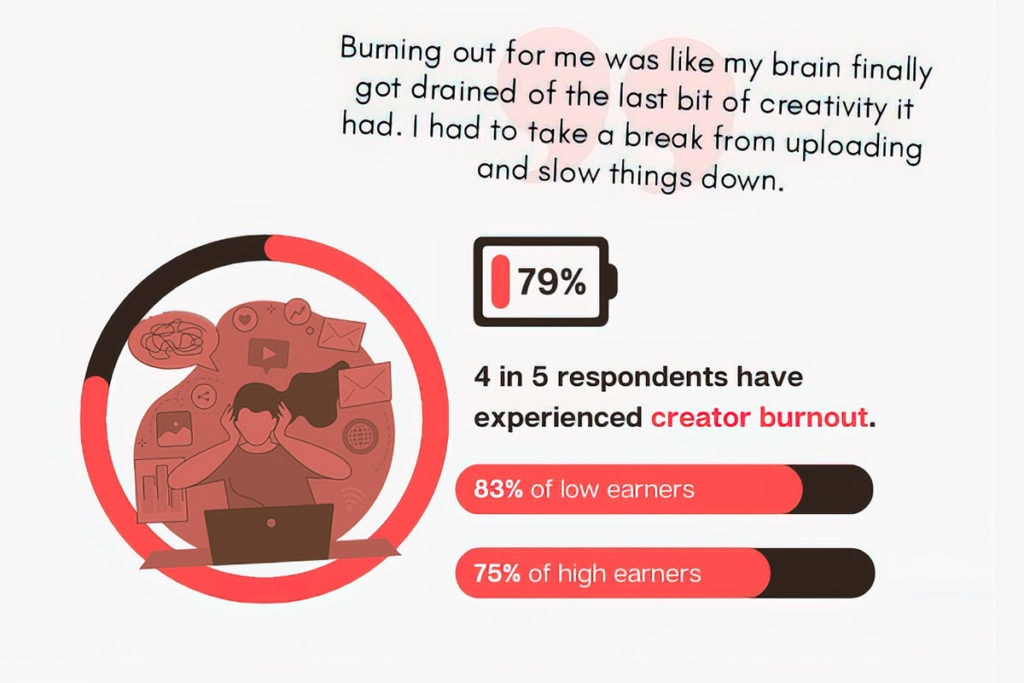How to avoid Blogger burnout when starting a blog
Are you feeling exhausted just thinking about your own blog? Blogging can seem thrilling—an opportunity to share your thoughts and build a community.
But let’s be real: Like myself, most of you who are starting a blog are probably juggling content creation, SEO optimization, and trying to keep up with the Kardashians of the blogging world.
On top of that, you might still have a full-time job that pays the bills, maybe have kids or a mountain of other things that constantly need your attention. The result of trying to balance all these? A one-way ticket to Burnoutsville.
You can’t help but reminisce about the good old days before you took on the challenge of starting a blog. Ah. You remember it like it was yesterday because maybe it was yesterday. You also start to wonder, are other bloggers feeling the same, or are you the only one?
But before you hang up your creative hat and slide into full-time Netflix binging, I’ve got some news for you. There’s a way to keep the blogging fire burning without getting scorched by blogging burnout.
Intrigued? Then follow along as we give you some tips for how to avoid blogger burnout when starting a blog.
Key Takeaways (TLDR)
- Reframing The Goal: Focus on setting smaller, achievable tasks.
- Changing Habits: Replace time-consuming, unproductive habits.
- Dealing With Creativity Blocks: Recognize writer’s block and shift focus.
The Core Issue and Why You Need This Guide When Starting A Blog
So, you’re excited about starting a blog, and you should be! Blogging is an excellent platform for personal expression, building a brand, or generating income. But like many things, the initial excitement can wane, replaced by stress and burnout as a blogger.
According to a study by Tastyedits, 79% of content creators experience some form of burnout, jumping to 83% for those struggling to monetize. Yikes!

In fact, I’ve seen a direct correlation between people joining blogging discussion groups and the number of people expressing how burned out they feel about blogging altogether. You need a plan to keep that flame alive and avoid being another statistic. This strategy keeps you on track without running you into the ground.
The Nitty-Gritty Details
1. Reframing the Goal for Small, Measurable Wins
Don’t aim to build Rome in a day; it was a multi-century project, you know? Launching a successful blog can evoke images of viral blog posts everywhere, adoring fans, and six-figure incomes. As glamorous as that sounds, the pressure to reach such lofty milestones can be overwhelming.
Reframing the goal means breaking these seemingly unreachable objectives into smaller, achievable tasks.
The Weight Loss Challenge
It’s a common tip health professionals use for people trying to lose weight. When people are trying to lose weight, often the first hurdle is dealing with not seeing immediate results. There isn’t much you can do about it. It is just human physiology. No matter how much exercise you do initially, your body will burn away fat as it sees fit. Often, every place other than where you want to see results.
When most people begin an exercise plan to lose weight, they actually gain weight because they build muscles which are denser and heavier than fat. This often leads people to think it’s not working, and they quit. So, some great advice that health professionals often suggest is reframing the goal. Instead of saying, “I’m going to lose 100 pounds this year,” and measuring daily, make your goals the activities that lead to weight loss.
For example, make it a goal to walk 10 minutes daily in the morning or eat one healthy snack at certain times to offset hunger. You can control these things. You know you are progressing towards your ultimate goal every time you achieve it. Think of it as stepping stones across a river—each stone you place brings you closer to the other side.
How to Execute
- Set Specific Goals: General goals like “I want to be successful” are almost as good as not having goals at all. Aim for something concrete: “I want to write a blog post each week about X topic.”
- Make Them Measurable: Attach numbers to your goals. Instead of saying, “I’ll increase my blog traffic,” say, “I’ll increase my blog traffic by 20% in three months.” Websites like Google Analytics can help you track these metrics.
- Time-Bound Them: Deadlines can be your best friend if you use them wisely. Commit to a specific timeframe for your goals, like “I’ll publish one high-quality blog post every Tuesday.”
- Celebrate the Little Wins: Every little milestone reached should be a reason for celebration. Got your first 100 subscribers? That calls for a mini-party. It doesn’t have to be elaborate like taking the family to Chuck-E-Cheese, just sharing your wins with your family or with other bloggers in the blogging community can be just as rewarding.
- Regularly Reevaluate: Setting goals is not a one-time thing; it’s an ongoing process. Every quarter, sit down and assess what you’ve achieved and what needs tweaking.
Real-World Examples
Imagine your end goal is to monetize your blog. Instead of focusing on that, your smaller goals might look like this:
- Week 1-2: Finalize the blog layout and design
- Week 3-4: Publish your first two articles
- Month 2: Promote your blog on social media to get at least 200 unique visitors
- Month 3: Start an email list and aim for 50 sign-ups
Once you’ve set some broad achievable goals, you can also set some easily achievable daily goals like this:
- Do keyword research on at least one topic every 2 days.
- Write an intro paragraph for a topic, spending no more than 30 minutes each morning.
- Send out one guest post proposal per day.
As you knock off these minor goals, you’ll find that you’re naturally progressing towards that bigger objective without the stress or burnout.
Think Like A Marathoner
Think about it like a marathoner. Very few people start their marathoning career tackling a 5-kilometer run right off the bat. However, everyone’s goal is to make it to a prestigious event like the Boston Marathon.
But the only way runners can measure improvement is by pacing themselves. Most of them are just trying to cut their time and increase their distance little by little. If you think it’s hard to move from writing one paragraph a day to two paragraphs a day, imagine trying to shave off 1 minute from a 3-hour marathon run.
The only way they can achieve it isn’t running faster at the start or sprinting at the finish. Marathons are about consistent pace and the energy to maintain it. A marathoner can’t always push beyond their limits; do it early, and you’ll crash later. Try to sprint at the finish, and you might not have enough fuel in the tank to finish. They have to focus on little changes in their daily habits, how many steps they can get in a day, how many calories they can intake, and how much sleep they get.
These are all things that they can control and measure, and it can take months before they shave off just 1 minute of their time. Like a marathoner, you might not know yet if you can write 1 paragraph a day or 100 posts a day. First, you must find your pace, set a rhythm, and adjust if it’s too slow or fast.
Reframing your goals isn’t about setting your sights lower; it’s about setting your sights on a series of attainable targets that lead you to your ultimate objective. And remember, every successful blogger or blog started with a single post. Yours is no different. So, keep calm, blog on, and let those small measurable wins pave your path to blogging stardom.
2. Replace Unproductive Habits with Productive Habits
Time management isn’t just for 9-to-5ers. As a blogger, making the best use of your time and having a blogging schedule is crucial. In the context of blogging, unproductive habits can range from procrastinating by scrolling through Twitter, binge-watching YouTube, or just spending time staring into space. Replacing these habits with productive behaviors could be a game-changer in your blogging journey.
How to Execute:
- Audit Your Time: The first step is to identify how you’re spending your time. A report from RescueTime showed that people spend an average of 3 hours and 15 minutes on their phones daily. If you fall within or above that average, imagine the amount of writing you could do instead!
- Cue, Routine, Reward: This principle, from Charles Duhigg’s ‘The Power of Habit,’ suggests that a habit (routine) is often triggered by a cue and rewarded. Identify the cue that leads you to procrastinate and replace the routine (unproductive habit) with writing a blog post, researching, or editing. Your reward? A well-crafted piece, and the satisfaction that comes with it.
- Chunking and Time Blocking: Instead of a to-do list, make a to-do schedule. Allocate specific time slots for different activities. Divide your blogging tasks into manageable ‘chunks.’ Allocate specific time blocks for each chunk. For example, use the first 30 minutes of your morning to outline your post and another 30 minutes later for research. This makes the work feel less daunting and more achievable.
- The Two-Minute Rule: James Clear, the author of “Atomic Habits,” offers this gem: “When you start a new habit, it should take less than two minutes to do.” Want to start writing as a daily habit? Begin with just two minutes a day. Over time, these small increments add up to substantial changes.
Instead Of Eating Cigarettes, I Eat Blog Articles
I have been telling myself to quit smoking for ages. I’ve done it before, a year here and there, a few months here and there. However, with the stress of starting a new blog, I didn’t just fall back into the habit. I was doubling up. Smoking was how I rewarded myself when I felt that jittery anxiety of being stuck while writing.
It wasn’t too long after that I started feeling pretty unhealthy, and that was when I was reminded of the principles I had learned from Duhigg’s book The Power of Habit and decided to proactively replace my smoking with something productive.
So rather than writing and inevitably feeling jittery after some time and using smoking as an escape mechanism. I flipped it around where I did other stuff, like keyword research, planning out social media posts, and other aspects of my blog. When I started feeling jittery, I rewarded myself with writing a bit for my blog. That jittery feeling never disappears; it’s part of my nature. However, I’ve replaced the habit of smoking with writing, and the reward is the accomplishment of making progress.
3. Know When to Let Go and Move On
Writer’s block happens. The key is not to let it consume you.
Dealing with Lack of Ideas
You’re staring at your laptop, and the cursor blinks back at you like a silent judge. You’re out of blog ideas or don’t know how even to start writing blog posts, and it feels like the end of the world. But relax, it’s not.
Here are some tips to help you when you are dealing with a blogging idea drought.
- Step Away: Literally. Close your laptop and do something different. Whether taking a walk or baking cookies, a change of scenery often works wonders.
- Inspiration Hunt: Visit other blogs, scroll through forums, or chat with people. Sometimes, ideas come from the most unexpected places.
- Brainstorming Session: Sit down and list out any ideas, however silly or trivial they might seem. The goal is to get the creative juices flowing again.
It turns out that people find their most creative ideas come when they’re not actively trying to solve a problem.
In fact, National Geographic wrote an article that discussed how some of the best ideas come to us while we are in the shower. They discuss the default mode network (DMN), which is the resting state of your brain when it’s not actively engaged. While you might think you are not thinking of anything, staring blankly at the wall, your subconscious is still working things out quietly in the back of your mind, running around, connecting thoughts and ideas.
Sometimes, letting go means allowing yourself to not have all the answers right away. Don’t worry, that blog content will come to you; when it does, it can come rushing in like a flood.
Writer’s Block
You know, ideas for the new blog posts you want to write about, but the words just won’t flow. You’re stuck in what seems like an eternal game of mental tug-of-war.
Here are some tips for dealing with writer’s block in blogging.
- Timed Writing Exercises: Set a timer for 10-15 minutes and write continuously without worrying about grammar or structure. The idea is to break the initial barrier.
- Outline First: Sometimes, starting with an outline can ease you into the writing process. Bullet points can guide you where full sentences feel too daunting.
- Talk it Out: If you can’t write it, say it. Use a voice recorder to verbalize your thoughts. You can transcribe these later and have a starting point. I often have my phone recorder app ready when driving to and from work to catch those glimpses of inspiration. It often starts sounding like nonsense, but there will be some gems in the end.
Numerous authors and writers have sworn by the “Pomodoro Method,” which involves writing in short, focused bursts. This approach can help you get past the initial block and into the flow state, where words come naturally. Consider looking up Pomodoro timers that can help you automate your writing rhythm. So, the key is to shift your approach and environment, whether it’s a scarcity of new ideas or the notorious writer’s block.
Maybe today isn’t the day you write your magnum opus blog post, and that’s alright. What matters is that you’re nurturing your creative self and recognizing when to push through and when to step back for a better view.
Key Considerations
- Prioritize Self-care: All work and no play makes Jack a dull (and burnt-out) boy. Make time for yourself.
- Be Flexible: Rigidity is a burnout catalyst. If a plan isn’t working, be ready to adapt. Create goals to write blog posts regularly and on a schedule, and if you miss it, don’t be hard on yourself. Just be aware of it and get yourself back on track, or adjust your plan to make it work.
- Seek Support: Whether it’s a blogging community or friends and family, a support system can be a burnout antidote.
Going Beyond
If you find yourself stuck creatively, maybe a short getaway or a ‘staycation‘ can give you the mental break you need.
Whenever I’m stuck on when writing. I reassure myself that the answer is there and it will come eventually. You just never know when. Often, when my mind wanders while driving or at the supermarket, that’s when the answer hits me.
So I’ve prepared tools just for those moments. For example, many of us use Skype daily for our work communications. So I created a group on my Skype called “Thoughts,” of which I’m the only member, and when I have these moments of creativity, I just pull out my phone and write it down. It’s a place that I know I use every day, and I’ll always be reminded of it. But now Skype has a feature called (You) chats, which you can use to make notes. Trust me, it’s a lifesaver and will actually save you time and energy because there’s nothing worse than having a great idea for your blog and forgetting it later.
Wrapping Up
Starting a blog with blogging goals is an exciting endeavor for most bloggers, especially when you feel like the sky’s the limit. But getting lost in the whirlwind of responsibilities attached to it is easy and will quickly bring you back down to earth.
By reframing your goals, adopting productive habits for constantly creating content, and knowing when to let go, you’re not just avoiding burnout but setting yourself up for long-term success. It’s good for your blog and your mental health.
So go ahead, give these tips a whirl, and get back to why you started blogging in the first place: because you have something valuable to say. There you have it, folks! Take it from me, a blogger who understands the ups and downs of the blogging journey. Keep your chin up and those fingers typing!
Frequently Asked Questions
Is it stressful to be a blogger?
Yes, blogging can be stressful due to the constant need for content creation, SEO optimization, and audience engagement. The juggling act between various tasks can often lead to burnout if not managed well, especially if you are doing it as a side hustle in addition to your day job.
Why do most bloggers fail?
Many bloggers fail due to unrealistic expectations, poor time management, and a lack of a well-defined strategy. Without setting achievable goals and measurable milestones, they get overwhelmed and disheartened.
Why do bloggers quit?
Bloggers often quit due to burnout, inadequate monetary returns, or waning passion for the topic. The initial enthusiasm can fade when faced with the day-to-day grind and the challenges of growing an audience.
Is blogging still profitable in 2023?
Yes, blogging remains profitable in 2023, especially with the rise of various monetization avenues like affiliate marketing, sponsored content, and digital products. However, success typically requires a strategic approach and time investment.







